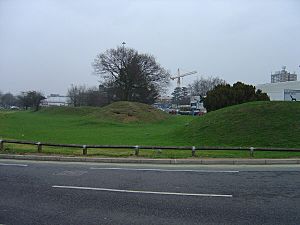Six Hills facts for kids
The Six Hills are a group of ancient Roman burial mounds, called barrows, located in Stevenage, Hertfordshire, England. They stand right next to the old Great North Road on Six Hills Common. These hills are very old and important, so they are protected by law as a Scheduled Ancient Monument. They are the biggest group of Roman burial mounds still existing in England. The hills are a famous local landmark and even gave their name to a road in Stevenage called Six Hills Way.
Contents
Uncovering the Past: The Six Hills Story
For nearly 2,000 years, people traveling along the old Roman road (which later became the Great North Road) have seen these six large mounds. For a long time, no one was quite sure why they were there or who built them.
Ancient Roman Burial Mounds
Most experts now agree that the Six Hills are Roman burial mounds, also known as barrows. They were likely built around 100 A.D. These mounds probably hold the cremated remains of a wealthy local family from Roman times. The ashes would have been placed in a container, along with special objects for use in the afterlife.
Local Stories and Legends
There's a fun local story about how the hills were made. People used to say the Devil created them! The legend goes that the Devil was sitting by the Great North Road, throwing clumps of earth at people passing by. He missed six times, and those misses became the Six Hills. In a fit of anger, he threw a seventh clump over his shoulder, hitting the church spire in Graveley and making it crooked. You can still see the crooked spire today! The story also says the holes in Whomerley Wood are where the Devil dug up his earth missiles.
Exploring the Hills: Past Digs
No new scientific archaeological digs have happened on the hills recently. However, people have dug into them in the past. These early investigations found only "a few pieces of wood and a piece of iron." At the time, these finds were dismissed as unimportant. But today, experts believe they were likely the remains of the original Roman burials.
Other reports mention damage to the hills over time. For example, a farmer was taking soil from the hills in 1750. Also, there was an attempt to make the Great North Road wider around 1820. Because of these events and natural wear, all the hills have lost over 4 feet (1.2 m) in height over the years.
Nature Around the Hills
The grass growing around these ancient burial mounds is very old. It contains special types of plants that are not found in newer grasslands nearby.
Unique Plant Life
Some of the interesting plants you can find here include bird's-foot trefoil, which has bright yellow flowers. There's also mouse-ear hawkweed, which looks a bit like a dandelion. You might also spot delicate harebells, tiny whitlow grass, and slender clover. These plants show how long the area has been undisturbed.
Images for kids



